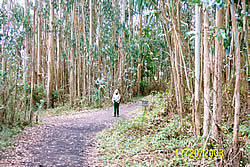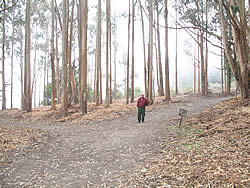
National Fire Plan Success Story
Tree Thinning Reduces Fire Hazard on Palomarin Trail
Point Reyes National Seashore, California
National Fire Plan - Fuels Reduction


Palomarin eucalyptus grove before treatment (top) and after treatment (bottom).
After 8 weeks of continuous tree cutting and chipping, the potential for wildfire along the Palomarin Trail at Point Reyes National Seashore has been significantly reduced. Approximately 10 acres of dense, non-native eucalyptus near the trailhead was treated during the summer of 2007 by a National Park Service hazardous fuels crew. This eucalyptus forest had developed from a small number of historic trees that were planted before the park was established.
The Palomarin Trail begins at the end of a long rural road, and is used by an estimated 60,000 people per year. There is only one way in and out of this area. A wildfire in this grove could move into the park interior, threatening people who could be trapped by steep cliffs, canyons, and dense vegetation. Wildfire moving into the park would quickly enter the Philip Burton Wilderness which could be severely impacted by suppression actions. This grove could also carry fire toward the community of Bolinas where there are numerous homes and businesses and a year round population of 2,500 residents. Between the grove and the community of Bolinas, a wildfire would also threaten a Point Reyes Bird Observatory field station, a Coast Guard facility, and Commonweal, an environmental health and research institute, which provides residential treatment for cancer patients.
High public use along the Palomarin Trail increases the potential for wildfire. The most recent fire along this trail was started by the illegal use of fireworks in July 2002.
Blue gum eucalyptus trees shed strips of bark and oily leaves which accumulate at the base of the trees, and hang from the branches. The fuel load in these non-native forests is approximately 31 tons per acre which is more than twice the fuel load of the native oak-bay woodlands.
All trees within the grove that were 12 inches in diameter or less were removed. Larger trees up to 24 inches in diameter were also removed if they were accessible to the trail system. The historic trees, often as much as 72 inches in diameter, were not removed. Some of the trees removed from the site were utilized for firewood and construction by the Permaculture Institute of Northern California, a non-profit organization located near the project area. Research and monitoring prior to the work determined the project would not negatively impact migrating monarch butterflies which have been known to overwinter in other groves nearby.
Contact: Roger Wong, Fire Management Officer, Phone: (415) 464-5232